

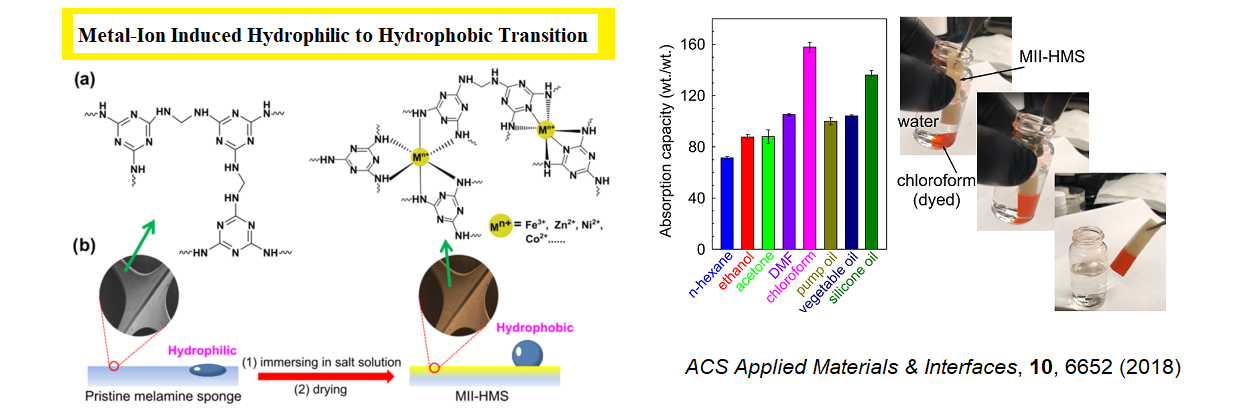
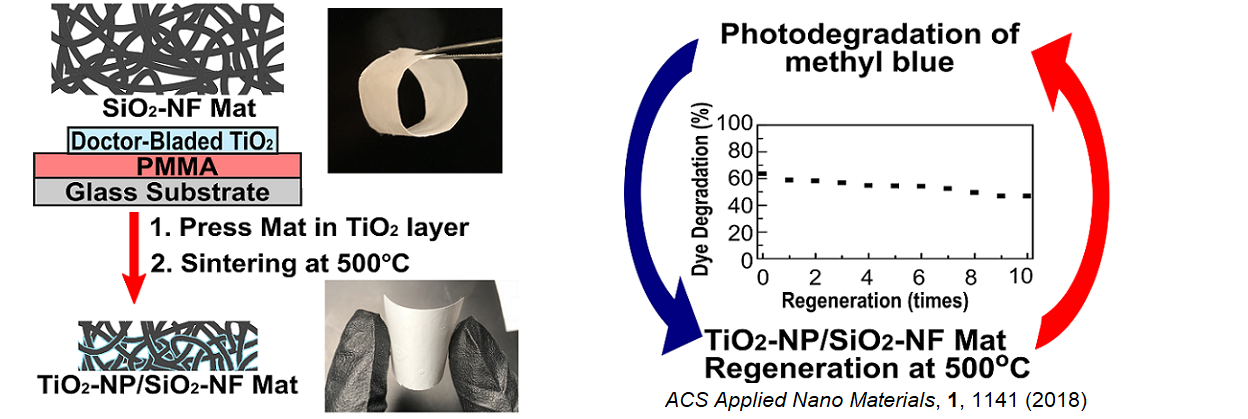
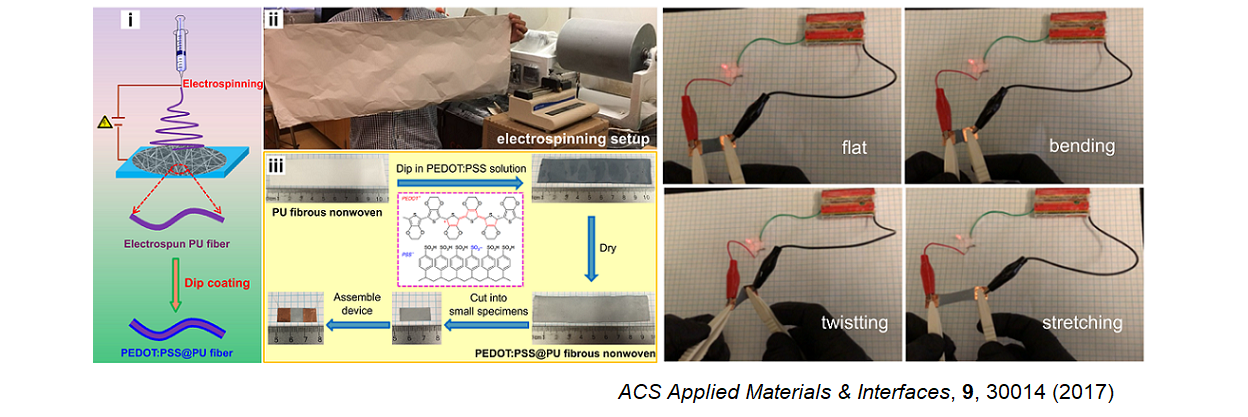

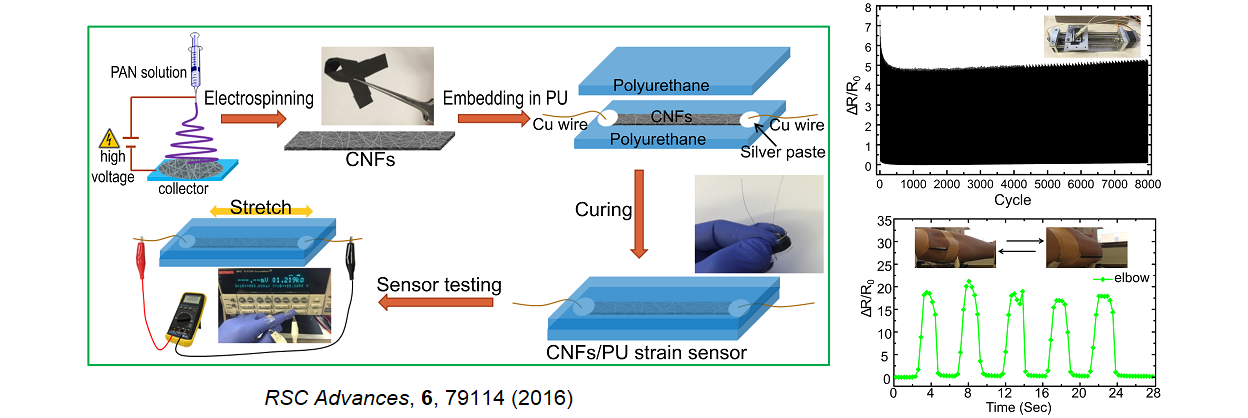
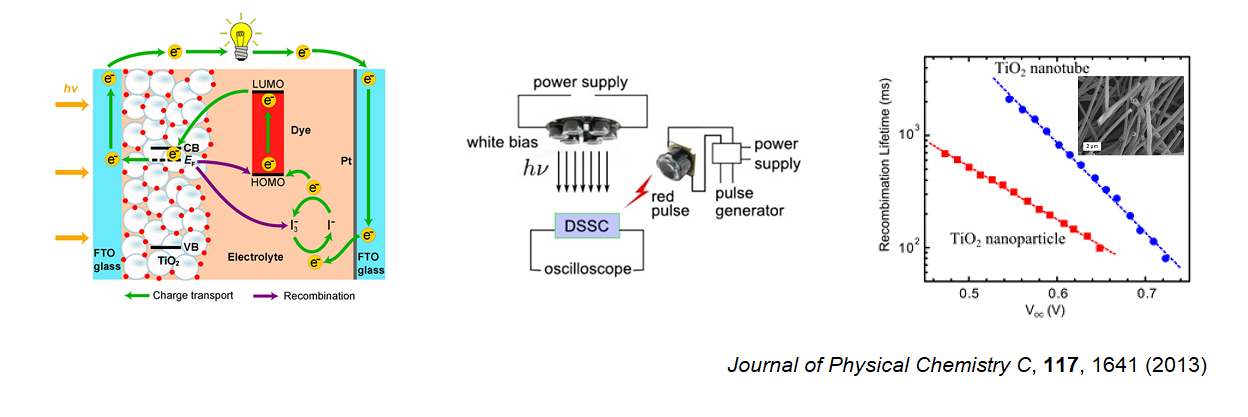

Our research seeks to understand and exploit interesting properties of multi-functional hybrid materials of conjugated polymer and inorganic nanostructure. Our group focuses on developing novel synthesis and fabrication methods, understanding the structure-property relations of the hybrid materials at the nanometer scale, and exploring the applications of these materials in flexible electronics and biomedical sensors. The research scope covers the multidisciplinary fields of chemistry, materials, applied physics, and nanotechnology. Current research projects include flexible/wearable electronic devices and sensors for human health monitoring and nanomaterials/device physics of dye-sensitized solar cells and photocatalytic environmental remediation. Our research has been supported by NSF, NASA, ACS PRF, and Research Corporation Cottrell College Science Awards, etc.
Dr. Zhengtao Zhu is an Associate Professor in the Department of Chemistry and Applied Biological Sciences at SDSM&T. He received his PhD in Materials Chemistry from the State University of New York at Binghamton in 2002. Prior to joining SDSM&T in 2006, Dr. Zhu was a postdoctoral associate at Cornell University (2002-2004) and University of Illinois at Urbana-Champaign (2004-2006).
Curriculum Vitae Google Scholar Site
Contact Information:
Dr. Zhengtao Zhu
Department of Chemistry and Applied Biological Sciences
South Dakota School of Mines and Technology
Rapid City, SD 57701
Email: Zhengtao.Zhu@sdsmt.edu
Phone: 605 394 2447
Research Overview
Our research seeks to understand and exploit interesting properties of multi-functional hybrid materials of conjugated polymer and inorganic nanostructure. Our group focuses on developing novel synthesis and fabrication methods, understanding the structure-property relations of the hybrid materials at the nanometer scale, and exploring the applications of these materials in flexible electronics and biomedical sensors. The research scope covers the multidisciplinary fields of chemistry, materials, applied physics, and nanotechnology. Here are a few examples of our work.
- Synthesis and fabrication of conducting polymer nanomaterials
- Dye-sensitized solar cells based on electrospun TiO2 nanofibers and organic dyes
- Flexible and wearable devices based on nanomaterials
1. Synthesis and fabrication of conducting polymer nanomaterials
Conducting polymers are new class of polymers with interesting optical and electronic (semiconducting or conducting) properties. Synthesis and preparation of conducting polymers, as well as their properties, have been studied extensively. Conducting polymers are also considered to have a great technology potential in flexible and wearable electronics. In recent years, we have developed novel methods for preparation of hybrid materials of conducting polymer and nanostructure. Through these research projects, we seek to develop and understand the methods to prepare the nanomaterials of conducting polymers as low temperature, which are compatible with the flexible substrates, and further explore their applications in flexible electronic devices and sensors.- “One-pot” synthesis of stable Pd/poly(3,4-ethylenedioxythiophene): poly(styrenesulfonate) (Pd/PEDOT:PSS) colloid. In the synthesis, the Pd/PEDOT:PSS aqueous dispersion was formed by simultaneous oxidationreduction reaction between Pd(NO3)2 and ethylenedioxythiophene (EDOT) at room temperature. The electric response of the Pd/PEDOT:PSS film to ammonia is investigated.
- Low-temperature seeding and hydrothermal growth of ZnO nanorod on poly(3,4-ethylene dioxythiophene):poly(styrene sulfonic acid). This work develops a low-temperature seeding process for hydrothermal growth of ZnO nanorods on flexible polymeric materials. The process involves decomposition of zinc (II) amine complex below 100 ◦C to form ZnO seeds, followed by hydrothermal growth using zinc nitrate hexahydrate and hexamethylenetetramine under 90◦C. The method enables the growth of ZnO nanorods on the polymeric film (e.g. PET) or the p-type conducting polymer poly(3,4ethylene dioxythiophene):poly(styrenesulfonic acid) (PEDOT:PSS) film to form ZnO/PEDOT:PSS heterojunction. The electric response of the heterojunction to the UV light is explored.
- Electrospun conducting polymer nanofibers. Electrospinning technique is a simple, efficient, and economic method for producing nonwovens composed of continuous and randomly overlaid fibers; these fibers have diameters typically in the range from tens of nanometers to several micrometers (commonly known as electrospun nanofibers). We have prepared the nanofibers of conducting polymers (such as Polythiophene and MEH-PPV) by electrospinning and studied the effect of nanoscale confinement and alignment on the optical properties of conducting polymers.
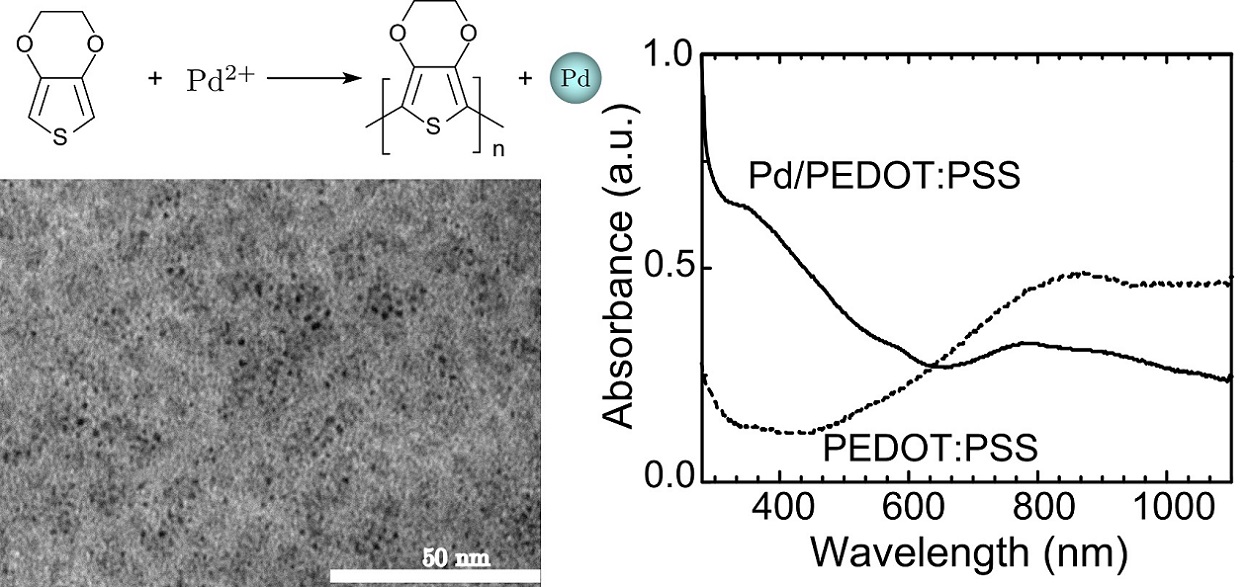
Synthetic Metals, 160, 1115 (2010).
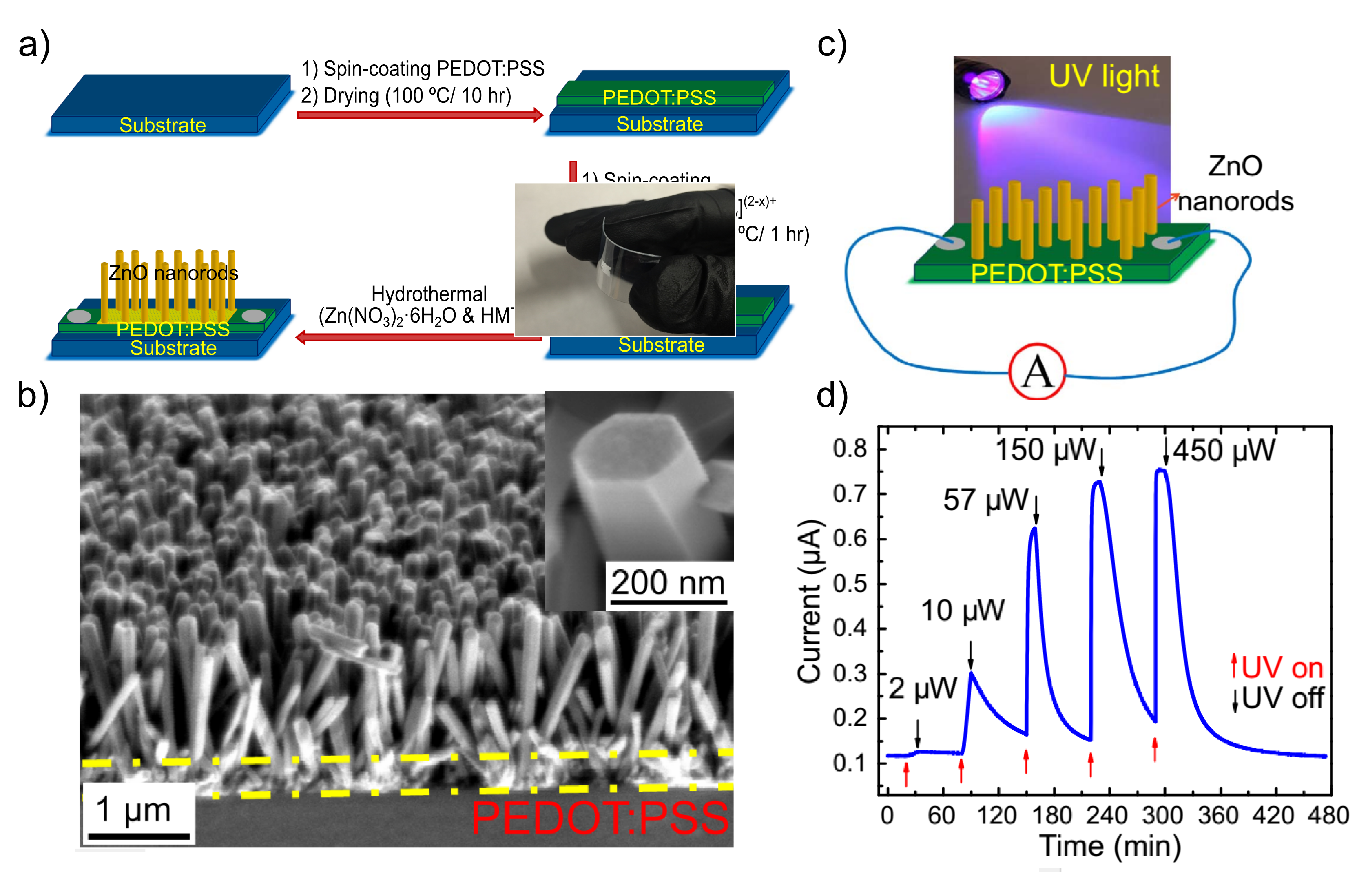
Materials Letters, 183, 197 (2016).
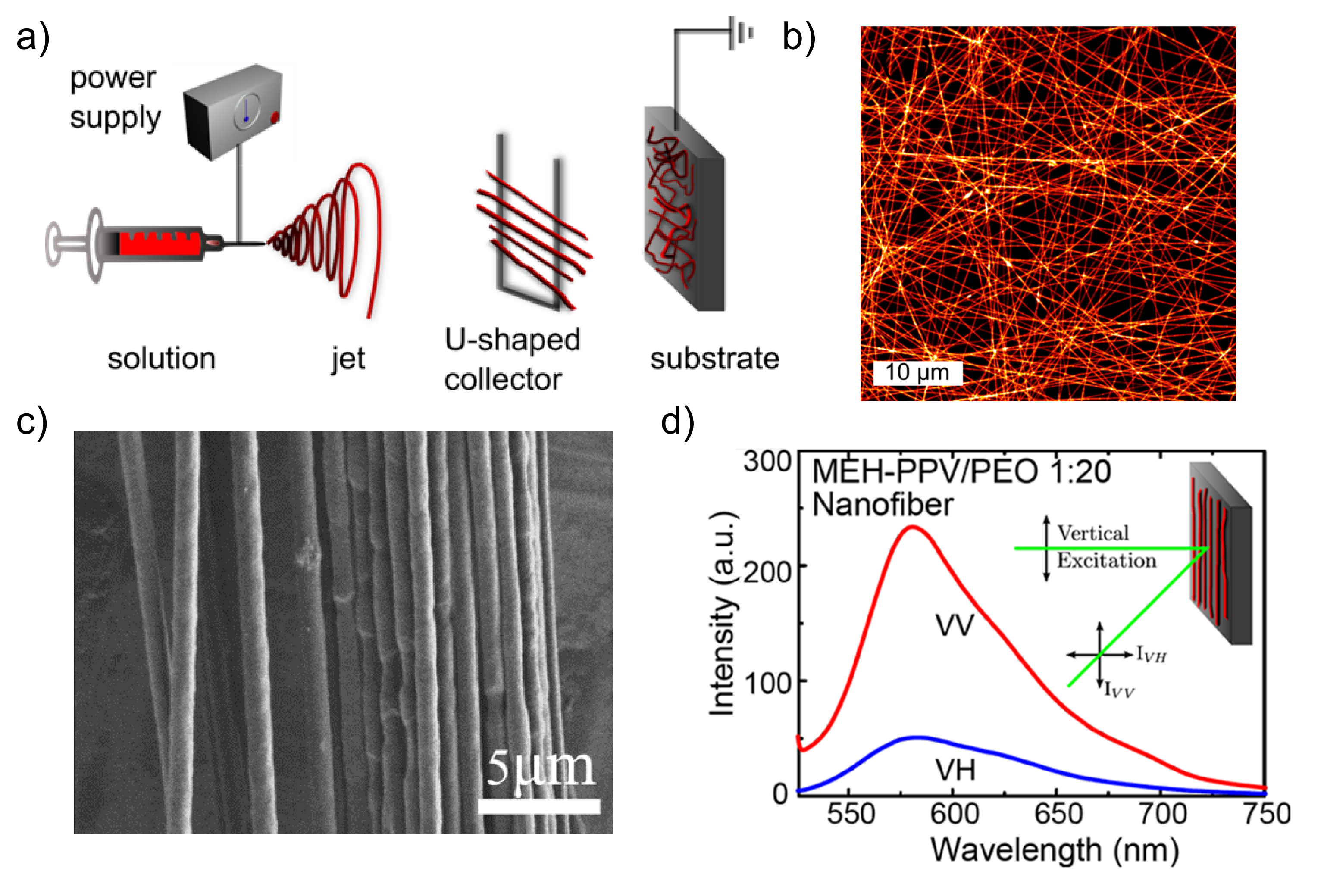
Journal of Materials Chemistry, 21, 444 (2010).
2. Dye-sensitized solar cells based on electrospun TiO2 nanofibers and organic dyes
Materials and technologies for next-generation renewable energy are the key areas to the environmental sustainability of human development. Compared with the conventional silicon-based solar cells, dye-sensitized solar cells (DSSCs) have the advantages of simple fabrication process, low-cost, low energy input, and environmentally friendly. We have worked on understanding the effects of materials on DSSCs.- Charge transport in electrospun TiO2 nanostructure. We have used electrospinning technique to prepare one-dimensional TiO2 nanostructures with different morphologies including nanofibers, nanotubes, and high-surface area TiO2 nanostructures. We have further studies the charge transport of these materials as photoanode in DSSCs by IV, photocurrent transient, and photovoltage transient characterization, and discovered that the one-dimensional structure significantly improves the charge transport of the photoanode.
- Metal-free organic dye. We have also investigated four new donor-(π-spacer)-acceptor organic dyes using triarylamine or carbazole as the electron-donating group, cyanoacrylic acid as the electronwithdrawing anchoring moiety, and naphtho[2,1-b:3,4-b’]dithiophene as the linker for DSSCs. The performance of DSSCs based on novel metal-free organic dyes as sensitizers suggests that the rigid and planar structure of naphtho[2,1-b:3,4-b’]dithiophene may be a valuable spacer group to design donor-π-acceptor molecular dyes and fine tuning of the chemical structures is needed for high-efficiency DSSCs. Additionally, we have investigated the effects of surface modification on the recombination and transport of DSSC based on donor-(π-spacer)-acceptor organic dyes.
- Thermal-durable, transferable, and flexible substrate of metal oxide. We have developed a universal dual-spinneret electrospinning method to prepare a thermal-durable, transferable, and freestanding mat of metal oxides for flexible DSSCs and photosensors. By simultaneously electrospinning of polycrystalline metal oxide (e.g. TiO2) with amorphous SiO2 using dual-spinneret setup followed by pyrolysis, the hybrid mats of metal oxide nanofibers that combine functionality, flexibility and high temperature durability can be prepared. We have demonstrated the flexible photosensors and photoanodes of DSSCs based on the dual-spinneret electrospinning method. In the composite photoanode, the TiO2 nanoparticles enhance the dye loading, the TiO2 nanofibers improve the electron transport, and the SiO2 nanofibers provide the mechanical strength/flexibility. The freestanding composite mat of TiO2 nanoparticles and electrospun TiO2/SiO2 nanofibers, as well as the preparation methods reported herein, not only is ideal for flexible DSSCs, but also can be applied for a broad range of flexible and low-cost energy conversion devices.
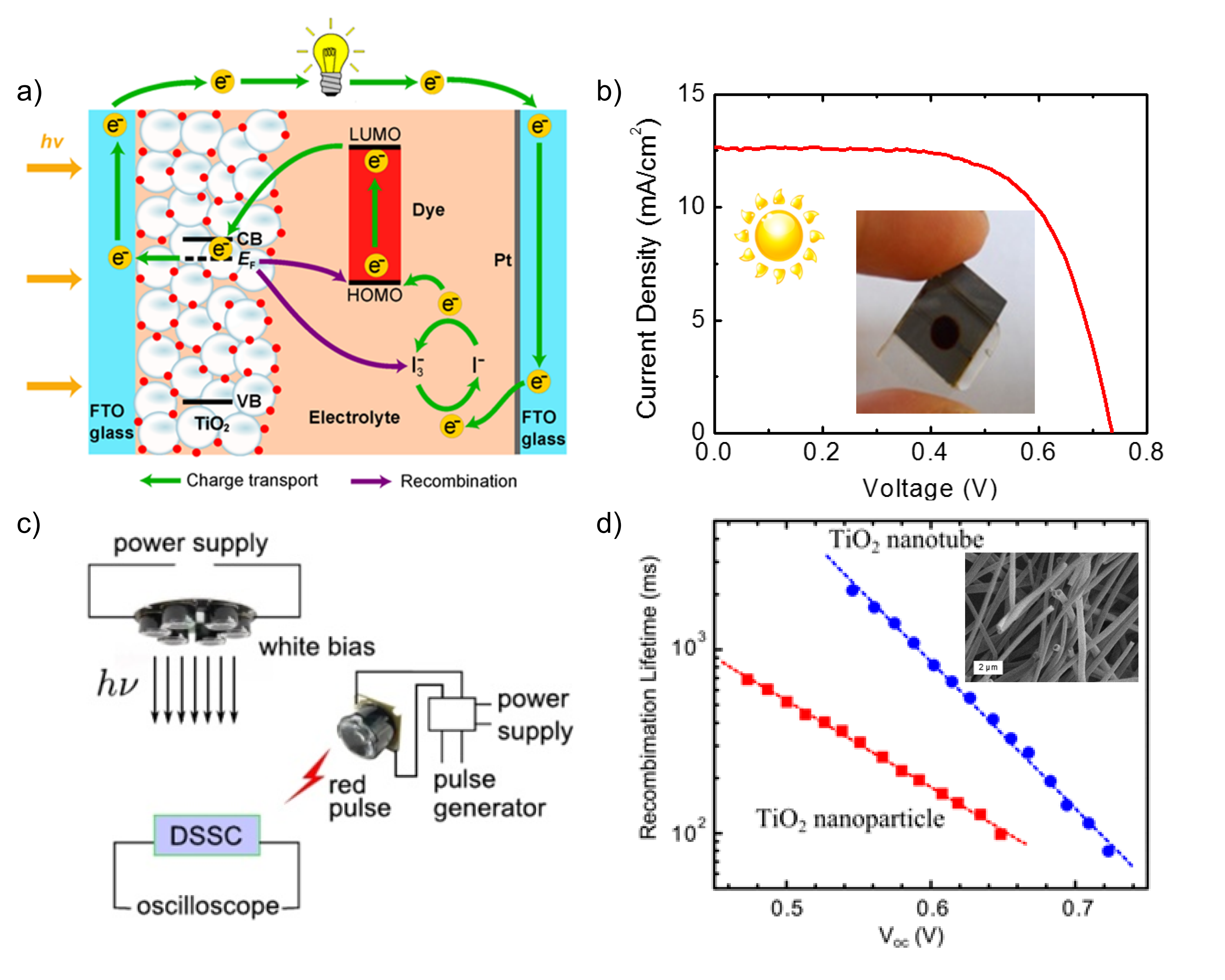
Journal of Physical Chemistry C, 117, 1641 (2013).
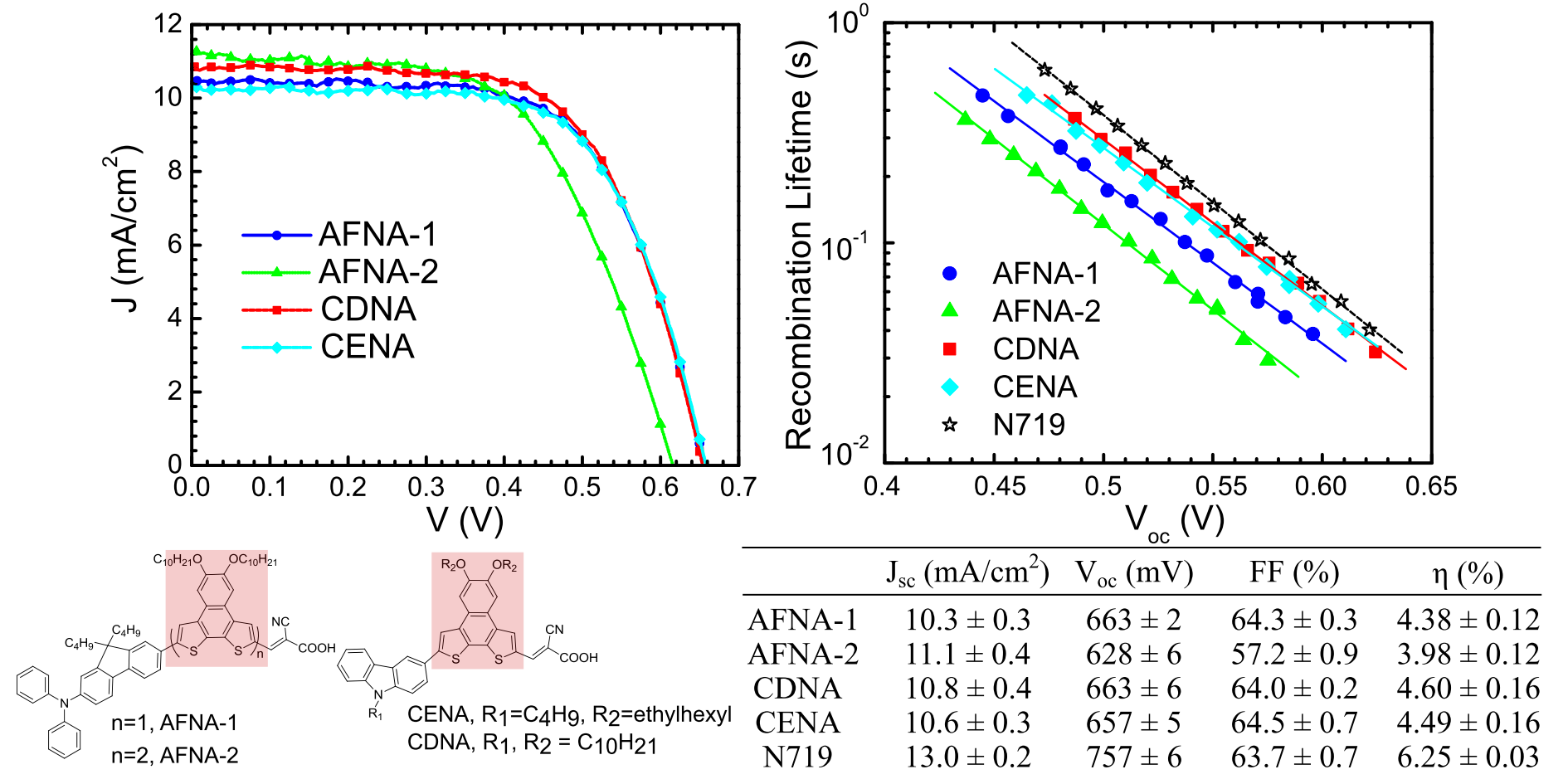
ACS Applied Materials & Interfaces, 6, 1926 (2014).
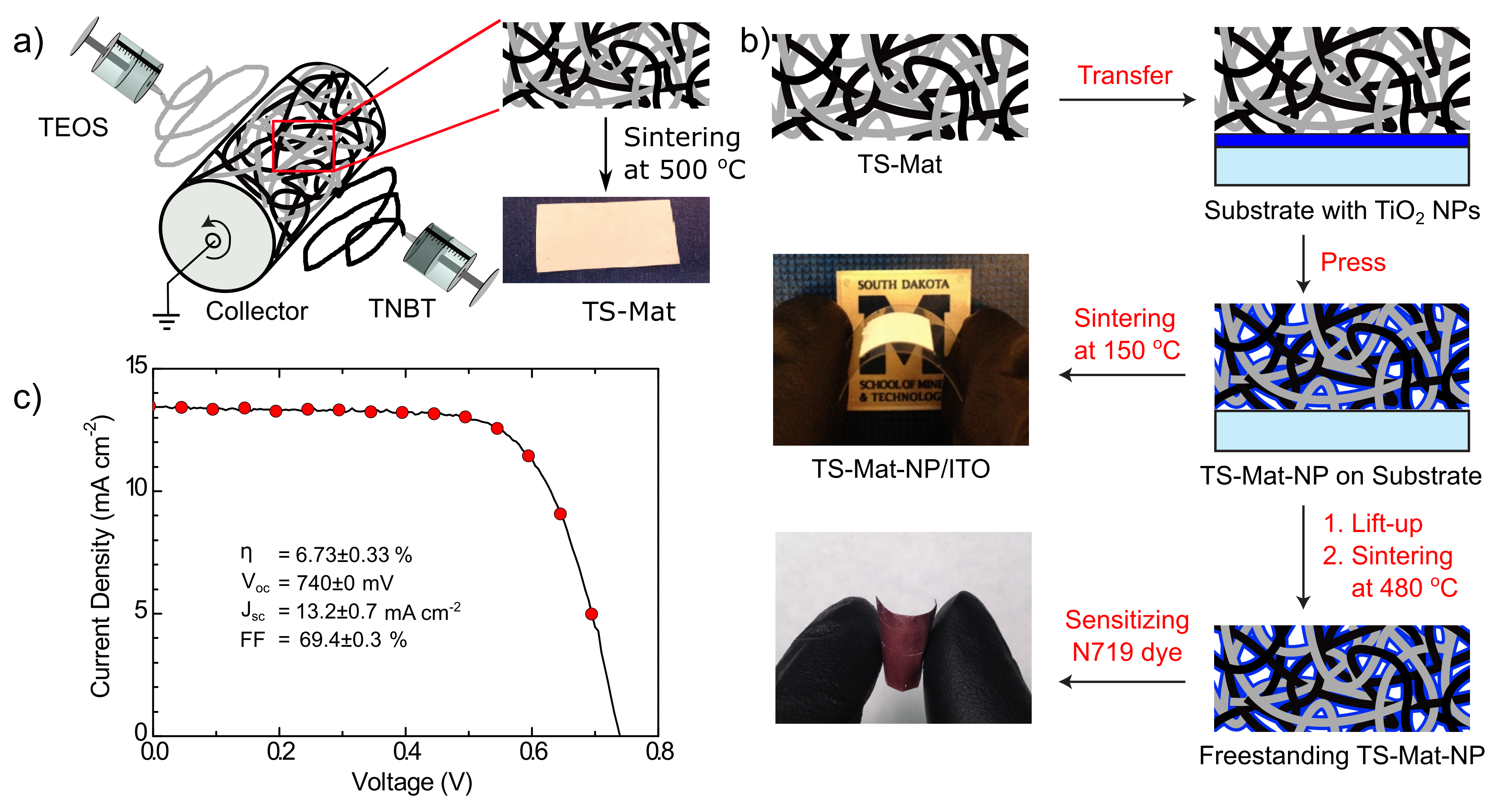
ACS Applied Materials & Interfaces, 6, 15925 (2014).
3. Flexible and wearable devices based on nanomaterials
Flexible electronics, i.e., electronic devices and sensors that are adaptable to a variety of substrate materials and surfaces covering large areas, will be a key enabling technology for next-generation aerospace applications, consumer electronics, and medical devices. For example, wearable systems consisted of conformable and lightweight biomedical and strain sensors, power sources, and wireless modules have great application potentials in human motion monitoring, medical, human-machine interface, safety, and soft-robotics. Development in this field is still in its infancy. The major challenge is that the conventional fabrication process of inorganic semiconductors for microelectronics is not compatible with the substrates and active materials for flexible and wearable devices. In recent years, my group has done several exploratory projects in the field of flexible and wearable electronics and sensors. Our research in this area focuses on combination of nanoscale fibers and soft materials (such as elastomers and hydrogels) to design multi-component and multi-functional composite materials as active components for wearable systems.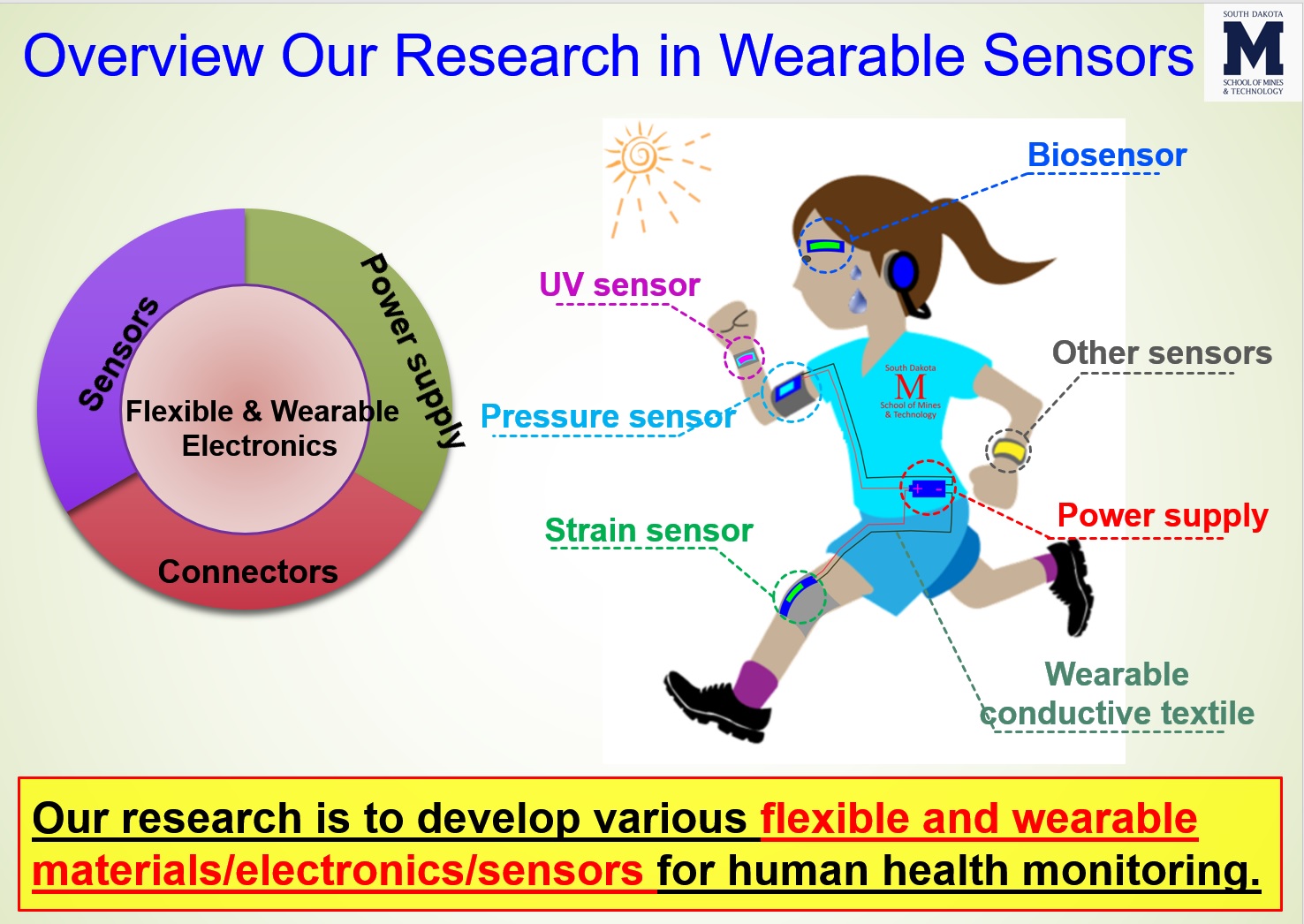
- Stretchable strain sensors. Highly stretchable and sensitive strain sensors are in great demand for human motion monitoring. This work reports a strain sensor based on electrospun carbon nanofibers (CNFs) embedded in polyurethane (PU) matrix. The piezoresistive properties and the strain sensing mechanism of the CNFs/PU sensor were investigated. The results showed that the CNFs/PU sensor had high stretchability of strain up to 300%, high sensitivity of gauge factor as large as 72, and superior stability and reproducibility during the 8000 stretch/release cycles. Furthermore, bending of finger, wrist, or elbow was recorded by the resistance change of the sensor, demonstrating that the strain sensor based on the CNFs/PU could have promising applications in flexible and wearable devices for human motion monitoring.
- Stretchable conductors. We have demonstrated a scalable and facile preparation of all-organic nonwoven that is mechanically stretchable and electrically conductive. Polyurethane (PU) fibrous nonwoven is prepared via the electrospinning technique; in the following step, the electrospun PU nonwoven is dip-coated with the conducting polymer poly(3,4-ethylenedioxythiophene): poly(styrenesulfonate) (PEDOT:PSS). This simple method enables convenient preparation of PEDOT:PSS@PU nonwovens with initial sheet resistance in the range of 35~240 Ω/sq (i.e., the electrical conductivity in the range of 30~200 S m-1) by varying the number of dip-coating times. The resistance change of the PEDOT:PSS@PU nonwoven under stretch is investigated. The PEDOT:PSS@PU nonwoven is first stretched and then released repeatedly under certain strain (denoted as pre-stretching strain); the resistance of PEDOT:PSS@PU nonwoven becomes constant after the irreversible change for the first 10 stretch-release cycles. Thereafter, the resistance of the nonwoven does not vary appreciably under stretch as long as the strain is within the pre-stretching strain. Therefore, the PEDOT:PSS@PU nonwoven can be used as a stretchable conductor within the pre-stretching strain. Circuits using sheet and twisted yarn of the nonwovens as electric conductors are demonstrated.
- Three-dimensional and ultralight conductive sponges. We have developed a general method to prepare three-dimensional (3D), highly porous, and conductive sponge with tunable conductivity for tactile pressure sensor. The 3D conductive sponge is prepared by assembly of shortened/fragmented electrospun nanofibers of polyacrylonitrile (PAN), polyimide (PI), and PAN-based carbon. The nanofibers of PAN, PI, and carbon are dispersed in water/ethanol with polyvinyl alcohol (PVA) and then freeze dried to form a 3D conductive sponge. Subsequently, the sponge is thermally treated at 230 oC; and the dehydrated PVA acts as a binder to uniformly bond electrospun carbon nanofibers (CNFs) on the mechanically resilient 3D scaffold of PAN/PI. Upon varying the amounts of CNFs, the resistance of the 3D nanofibrous sponge is readily tailored from 260 kΩ to 200 Ω. The resistance change of the 3D conductive sponge under the cyclic compressive strain is investigated, and the results are correlated with the unique interconnected and hierarchically structured pores in the sponge. A tactile pressure sensor array composed of 25 devices of conductive sponges is demonstrated.
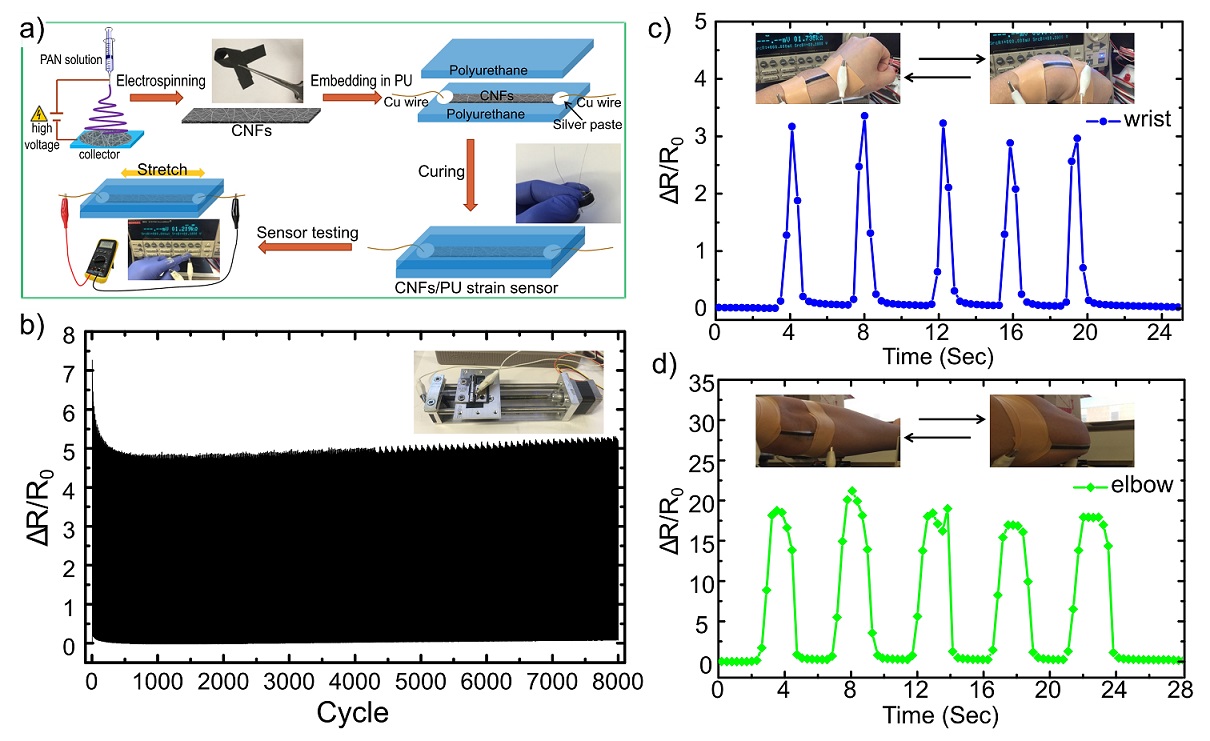
RSC Advances, 6, 79114 (2016).
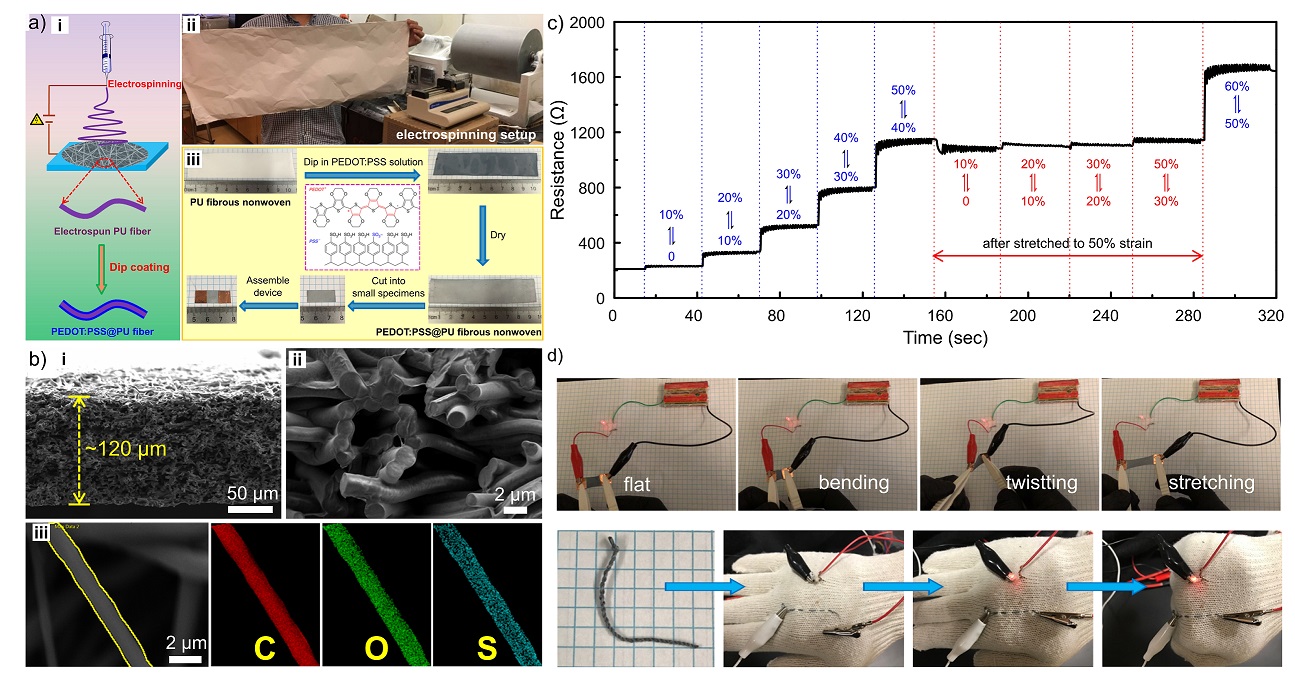
ACS Applied Materials & Interfaces, 9, 30014 (2017).
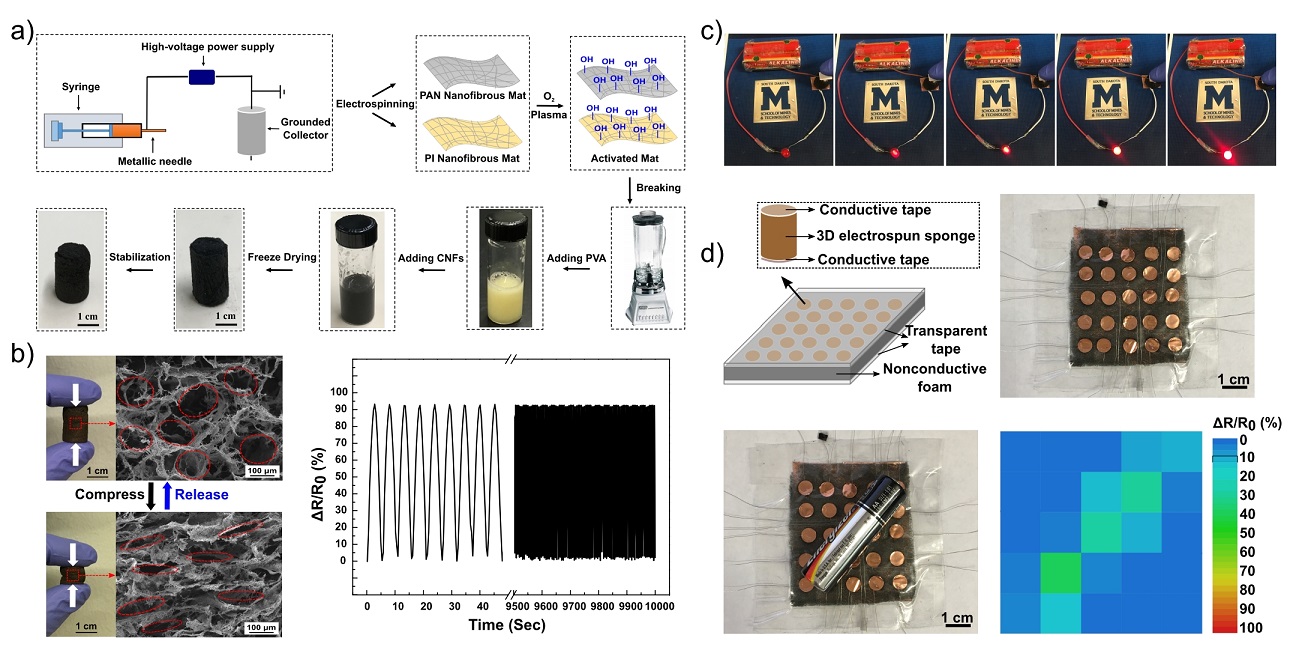
Journal of Materials Chemistry C, 5, 10288 (2017).
Research Funding
- “Wireless body area network in space: Development of wireless health monitoring system with flexible and wearable sensors.” Administrative PI: Edward F. Duke; Science PI: Yanxiao Zhao; Co-PIs: Zhengtao Zhu, Hao Fong, Charles Tolle, Moses Ikiugu, Hyeun Joong Yoon, Manki Min. Total Award Amount: $750,000. Source of Support: NASA EPSCoR. Total Award Period Covered: 01/01/2018–12/31/2020.
- “Center for advanced sensors (CAS).” Principal Investigator (PI): Qiquan Qiao; Co-PIs: David Aaron, Hao Fong; Aaron Franzen; Timothy Hansen, Dennis Helder, Huitian Lu, Zhen Ni, Yunpeng Pan, Sung Shin, Alevitina Smirnova, Songxin Tan, Reinaldo Tonkoski, Myounggyu Won, Hyeun Joong Yoon, Zhengtao Zhu. Total Award Amount: $65,350. Source of Support: SDBOR. Total Award Period Covered: 07/01/2016–05/31/2017.
- “Flexible electronics for space applications: Development of new materials and device processing technologies.” Administrative PI: Edward F. Duke; Science PI: Zhengtao Zhu; Co-PIs: Steve Smith, Phil Ahrenkiel, Haeyeon Yang, Qiquan Qiao, Cheng Zhang, David Galipeau. Total Award Amount: $750,000. Source of Support: NASA EPSCoR. Total Award Period Covered: 01/01/2013–12/31/2016.
- “Fluoride-ion battery prototype development.” PI: David Salem; Co-PIs: Steve Smith, Haiping Hong, Phil Ahrenkiel, Zhengtao Zhu. Total Award Amount: $25,000/month. Source of Support: Trion (formerly Waterford Energy Solutions Corporation.) Total Award Period Covered: 03/01/2015–12/31/2016.
- “MRI: Development of novel instrumentation to probe nanoscale charge carrier dynamics with high temporal and spatial resolution.” PI: Qiquan Qiao; Co-PIs: Zhengtao Zhu, Cheng Zhang, and David Galipeau. Total Award Amount: $450,065. Source of Support: National Science Foundation. Total Award Period Covered: 09/01/2014–08/31/2017.
- “A disposable electrochemical field-effect sensor based conducting polymer hydrogel for detection of tear film MMP-9 inflammatory marker.” PI: Zhengtao Zhu; Co-PI: Steve Smith. Total Award Amount: $38,128. Source of Support: BioSNTR. Total Award Period Covered: 03/01/2015–06/30/2016.
- “Electrochemical laboratory for R&D in power generation and storage.” PI: Alevtina L. Smirnova; Co-PIs: Zhengtao Zhu, Hao Fong. Total Award Amount: ~$100,000. Source of Support: SD BOR FY14 Research and Development Innovation Grant. Total Award Period Covered: 01/01/2014–01/31/2015.
- “MRI-R2: Acquisition of a thin-film deposition glovebox system for organic electronics and energy-related nanoscience research and education.” PI: Zhengtao Zhu; Co-PIs: Hao Fong, Rajesh Shende, Steve Smith. Total Award Amount: $163,438. Source of Support: National Science Foundation. Total Award Period Covered: 03/01/2010–02/28/2012.
- “Probing the interactions between conjugated polymer and ZnO nanostructure through nanostructure surface engineering.” PI: Zhengtao Zhu. Total Award Amount: $40,000. Source of Support: Research Corporation Cottrell College Science Awards. Total Award Period Covered: 08/31/2009–06/30/2012.
- “Development of an advanced photovoltaic materials research cluster in South Dakota.” Administrative PI: Edward F. Duke; Science PI: Steve Smith; Co-PIs: Qiquan Qiao, David Galipeau, Zhengtao Zhu, Phil Ahrenkiel, Xingzhong Yan. Total Award Amount: $750,000. Source of Support: NASA EPSCoR. Total Award Period Covered: 10/01/2009–09/30/2012.
- “Charge transfer and charge transport in nanofibers of conjugated polymer/ZnO nanoparticles.” PI: Zhengtao Zhu. Total Award Amount: $40,000. Source of Support: American Chemical Society–Petroleum Research Fund. Total Award Period Covered: 09/01/2007–08/31/2010.
- “Chemical sensors based on conducting polymer and nanoparticle composites.” PI: Zhengtao Zhu. Total Award Amount: $5,000. Source of Support: Nelson Research Award. Total Award Period Covered: 07/01/2007–06/30/2008.
- “Flexible chemical sensors based on nanocomposite of conjugated polymer/ZnO nanoparticle transistors for aeronautic and space applications.” PI: Zhengtao Zhu. Total Award Amount: $10,000. Source of Support: South Dakota NASA EPSCoR Research Initiation Grant. Total Award Period Covered: 01/01/2008–08/31/2008.
Research Facilities
Lab Equipment:
- MBraun Glovebox system equipped with thermal evaporator and spincoator
- Sample cleaning setup (oxygen plasma, Laminar-flow hood, 18MΩ DI water system)
- Chemical synthesis setup for air-sensitive reactions (Schlenk lines)
- Newport 150W Solar Simulator and monochromator for IPCE measurement
- Laboratory-produced photovoltage and photocurrent transient setup for photovoltaic cells
- Keithley 2612 dual channel source meter, Keithley 2000 source meter for electric characterization
- Probe station for probing the electronic devices
- Perkin-Elmer LS-55 fluorescence spectrometer
- Perkin-Elmer Lambda-650 UV/Vis spectrometer
- Metrohm Potentiostat with impedence module
- Dark room for simple lithographic patterning
- KLA-Tencor D100 profilometer
- Nanoimprint Technology CNI nanoimprint tool
Major Instruments Available at the SDSM&T for Material Characterization
- Zeiss Supra 40VP field-emission Scanning Electron Microscope (SEM) including a Tracor-Northern (Noran Instruments) energy-dispersive X-ray analyzer for elemental analysis
- High-resolution JEOL JEM-2100 LaB6 transmission electron microscope (TEM)
- Hitachi H-7000 FA Transmission Electron Microscope (TEM), that includes an H-7110 scanning transmission (STEM) module and a Kevex energy-dispersive X-ray spectrometer
- Quantasorb BET Surface Area Analyzer
- Digital Instruments Nanoscope IIIa Multi-Mode Atomic Force Microscope (AFM)
- Philips PANalytical X’Pert Pro X-ray Diffractometer (XRD)
- Renishaw 100 micro-Raman Spectrometer (with 633 nm He-Ne laser and 782 nm diode laser) and Olympus BH2-UMA microscope, Renishaw Wire Video Viewer software
- TA Instruments, Q100 Differential Scanning Calorimeter
- TA Instruments, Q400 Thermal Mechanical Analyzer
- GE QE Plus 300 MHz NMR Spectrometer
- Microtrac 3100, Laser Diffraction Particle Size Analyzer (Range: 0.02 to 3000 micron)
- Atomic Force Microscopy combined with SPM, KFM, etc
- Mass spectrometry (ESI-MS)
- Nuclear magnetic resonance spectroscopy (300 MHz NMR)
Peer-Reviewed Publications
Teaching
Undergraduate Courses
- CHEM 112 : General Chemistry I (3 credits)
- CHEM 112L: General Chemistry I Laboratory (1 credit)
- CHEM 252 : Descriptive Inorganic Chemistry (3 credits)
- CHEM 452 : Inorganic Chemistry (3 credits)
- CHEM 452L: Inorganic Chemistry Laboratory (1 credit)
- CHEM 344L: Physical Chemistry Laboratory (1 credit)
Graduate Courses
- CHEM 552: Inorganic Chemistry (3 credits)
- MES 604: Chemistry of Materials (4 credits)
- NANO 715: Polymeric Nanomaterials (3 credits)
- NANO 717: Nanochemistry (3 credits)
- BME/NANO/MES 719: Nanomaterials for Biosensors (3 credits)
Group News
- 1/2019 Bradley Spurlock, a graduate student in Biomedical Engineering Program joined the group. Welcome!
- 2/2019 Dr. Yichun Ding's review paper on wearable sensors based on the piezoresistive 3D monolithic conductive sponges published in ACS Applied. Materials & Interfaces.
- 9/2018 Obiora Onyilagha, a graduate student in Nanoscience and Nanoengineering Program, joined the group. Welcome!
- 7/2018 Yichun successfully defeneded his PhD dissertation. He will join Fujian Institute of Research on the Structure of Matter, Chinese Academy of Sciences as an associate professor. Congraduations!
- 4/13/2018 Yichun's paper on wearable pressure sensor for human motion monitoring is accepted in ACS Applied Materials & Interfaces.
- 4/2018 Yichun received the Outstanding Graduate Student Award.
- 4/2//2018 Fan successfully defended her PhD dissertation. Well done, Dr. Zheng!
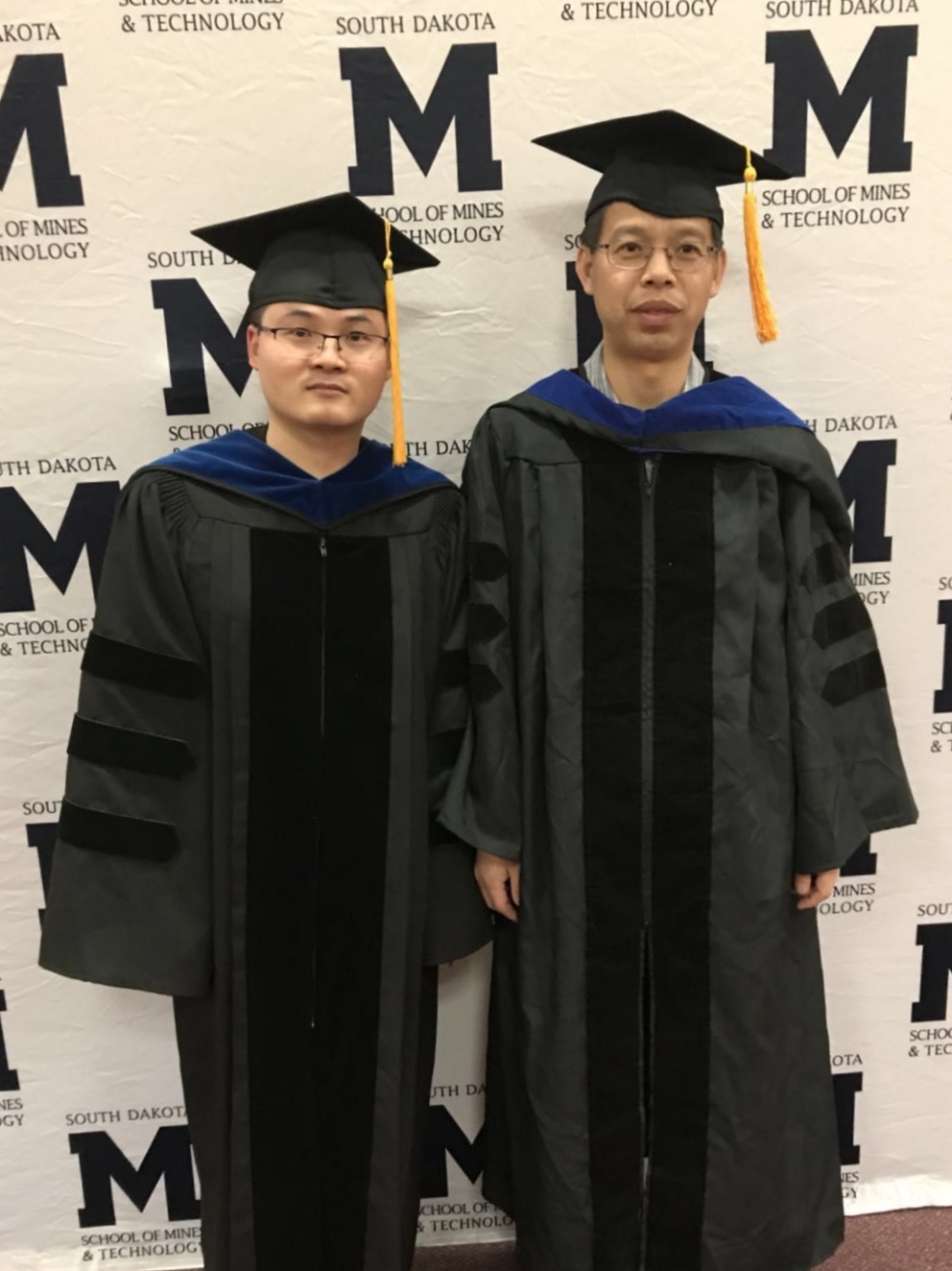
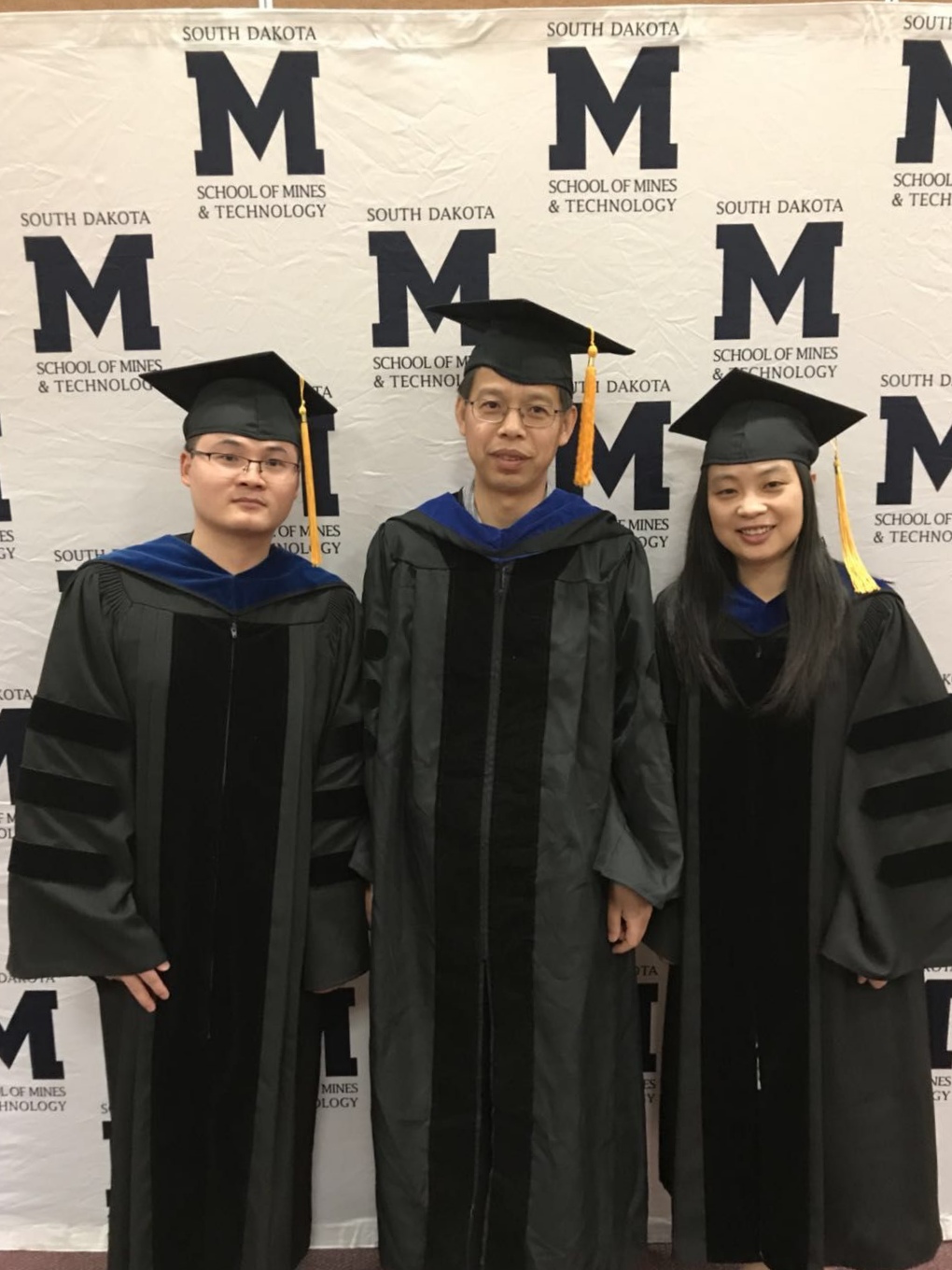
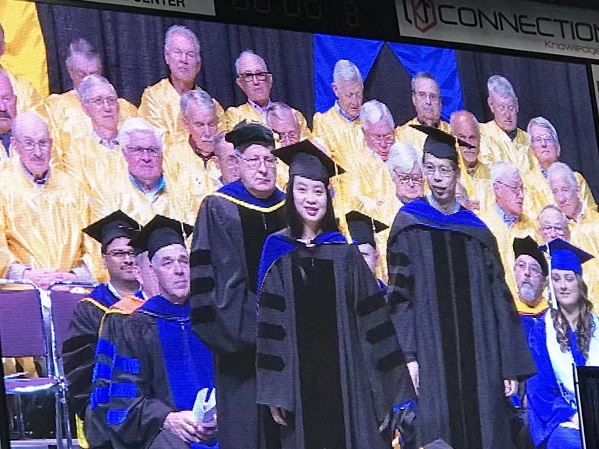
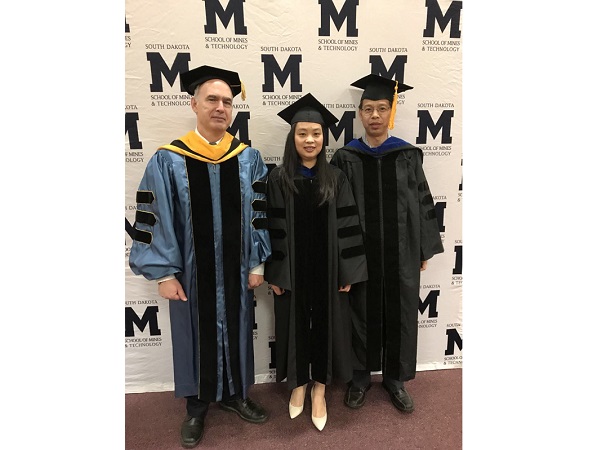
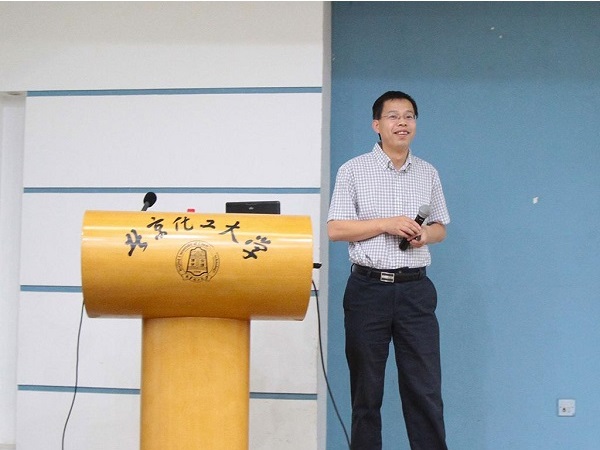


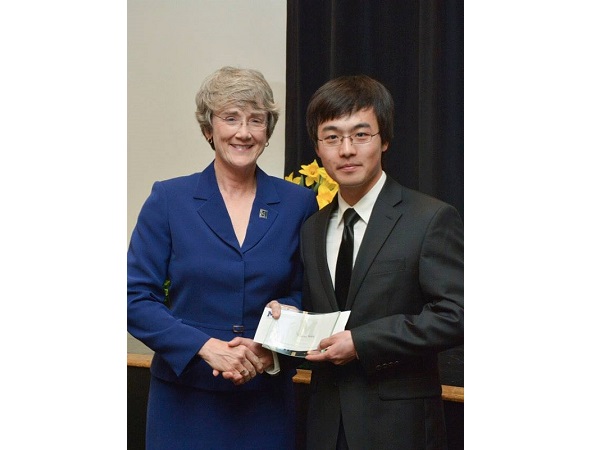
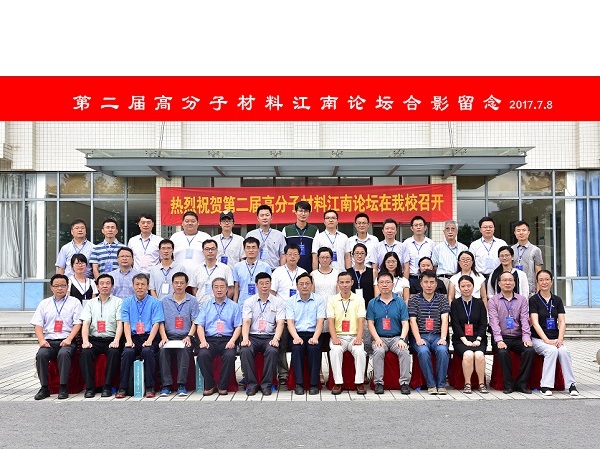
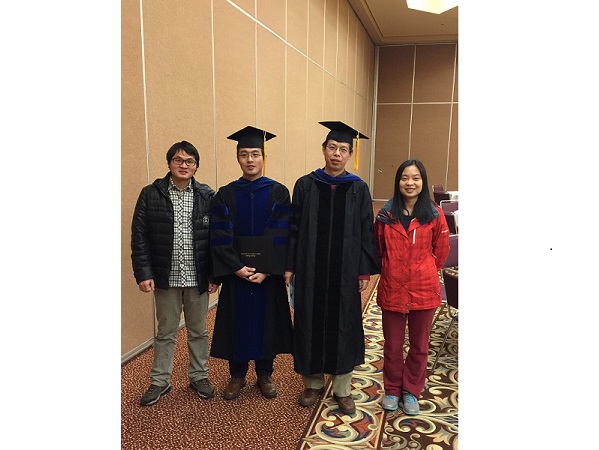
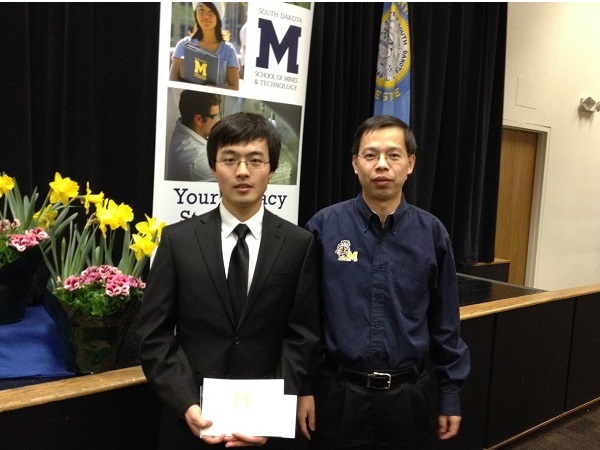
Former Students
- Dr. Yichun Ding, Ph.D. Student, Biomedical Engineering Program, 2014-2018. Dr. Ding is an associate professor at Fujian Institute of Research on the Structure of Matter, Chinese Academy of Sciences.
- Dr. Xiaoxu Wang, Ph.D. Student, Nanoscience and Nanoengineering, 2010-2014; Research Scientist, 2014-2015. Dr. Wang is an associate professor at Beijing University of Chemical Technology.
- Dr. Fan Zheng, Ph.D. Student, Nanoscience and Nanoengineering, 2012-2018. Dr. Fan is a research associate at CAPE Lab in South Dakota School of Mines and Technology.
- Mr. Casey Clegg, M.S. in Materials Engineering and Science, 2013-2014. Current position: Application Engineer in Moxtek.
- Mr. Kezhen Yin, M.S. in Materials Engineering and Science, 2008-2010. Dr. Yin recieved his Ph.D. in Polymer from Case Western Reserve University.
- Ms. Rachael Jetson, M.S. in Material Engineering and Science, 2007-2008. Dr. Jetson received her Ph.D. in Medicinal Chemistry from University of Toledo in Ohio.
- Ms. Amanda Nelson, B.S. in Chemistry, graduated in 2012, in my group from Fall 2010 to Fall 2011. Ms. Nelson is a Quality Technician III, ConAgra Foods.
- Mr. Cameron Thompson, B.S. in Chemistry, graduated in 2012, in my group in Spring 2008.
- Ms. Ahn Pham, B.S. in Chemistry/Chemical Engineering, in my group in Fall 2010. Ms. Pham went to University of Arkansas.
- Mr. Jordan Speidel, B.S. in Chemistry, graduated in 2008. Dr. Speidel received his Ph.D. from University of Texas Medical Branch.
- Ms. Katrina Donovan, B.S. in Chemistry, graduated in 2010. Ms. Donovan is a Ph.D. student in University of Oregon.
Running
Dr. Zhu is a serious marathon runner. He started running in 2011. Dr. Zhu finished his first marathon in 4 hours 18 minutes at the Deadwood Mickelson Trail Marathon. Since then, he has been running two marathons every year. One of his running goals is to run marathons in all 50 states.- Deadwood Marathon, 4:18:30, June 2, 2013, Deadwood, SD
- Estes Park Marathon, 4:11:34, June 22, 2014, Estes Park, CO
- Mankato Marathon, 3:35:26, October 19, 2014, Mankato, MN
- Maine Coast Marathon, 3:52:08, May 09, 2015, Biddeford, ME
- Chicago Marathon, 4:41:11, October 11, 2015, Chicago, IL
- University of Okoboji, 3:58:39, July 16, 2016, Okoboji, IA
- Tucson Marathon, 3:22:43, December 10, 2016, Tucson, AZ
- Revel Mt Charleston, 3:37:20, April 29, 2017, Las Vegas, NV
- Platte Valley Companies Monument Marathon, 4:22:40, September 30, 2017, Gering, NE
- Fargo Marathon, 3:43:38, May 19, 2018, Fargo, ND
- Cheyenne Marathon, 4:02:24, September 23, 2018, Cheyenne, WY